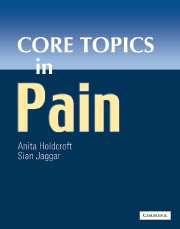Book contents
- Frontmatter
- Contents
- Contributors
- Preface
- Acknowledgements
- Foreword
- General abbreviations
- Basic science abbreviations
- PART 1 BASIC SCIENCE
- PART 2 PAIN ASSESSMENT
- Section 2a Pain measurement
- Section 2b Diagnostic strategies
- PART 3 PAIN IN THE CLINICAL SETTING
- Section 3a Clinical presentations
- Section 3b Pain syndromes
- PART 4 THE ROLE OF EVIDENCE IN PAIN MANAGEMENT
- PART 5 TREATMENT OF PAIN
- Section 5a General Principles
- Section 5b Physical treatments
- 34 Physiotherapy management of pain
- 35 Regional nerve blocks
- 36 Principles of transcutaneous electrical nerve stimulation
- 37 Acupuncture
- 38 Neurosurgery for the relief of chronic pain
- Section 5c Pharmacology
- Section 5d Psychosocial
- PART 6 SUMMARIES
- Glossary
- Index
36 - Principles of transcutaneous electrical nerve stimulation
from Section 5b - Physical treatments
Published online by Cambridge University Press: 10 December 2009
- Frontmatter
- Contents
- Contributors
- Preface
- Acknowledgements
- Foreword
- General abbreviations
- Basic science abbreviations
- PART 1 BASIC SCIENCE
- PART 2 PAIN ASSESSMENT
- Section 2a Pain measurement
- Section 2b Diagnostic strategies
- PART 3 PAIN IN THE CLINICAL SETTING
- Section 3a Clinical presentations
- Section 3b Pain syndromes
- PART 4 THE ROLE OF EVIDENCE IN PAIN MANAGEMENT
- PART 5 TREATMENT OF PAIN
- Section 5a General Principles
- Section 5b Physical treatments
- 34 Physiotherapy management of pain
- 35 Regional nerve blocks
- 36 Principles of transcutaneous electrical nerve stimulation
- 37 Acupuncture
- 38 Neurosurgery for the relief of chronic pain
- Section 5c Pharmacology
- Section 5d Psychosocial
- PART 6 SUMMARIES
- Glossary
- Index
Summary
Principles of transcutaneous electrical nerve stimulation
Transcutaneous electrical nerve stimulation (TENS) is the electrical stimulation of peripheral nerves for temporary analgesic effects.
Historically the description of using electricity in pain medicine is not new:
2500 BC Egyptian Fifth Dynasty — stone carvings depict the use of electrical fish to treat pain.
400 BC Hippocrates — electrical fish used for treatment of headaches and arthritis.
46 AD Scribonius Largus — electrical ray fish used for gout.
1756 Richard Lovett — first English textbook on medical electricity.
Theories of pain modulation using TENS
Spinal pre-synaptic inhibition (traditional TENS)
The gate control theory suggests that stimulation of large diameter, fast conducting afferent sensory (Aβ) fibres produces pre-synaptic inhibition within the dorsal horn (DH) of the spinal cord. This may effectively block further transmission in smaller, slower conducting (nociceptive) afferent C-fibres, which may be carrying noxious information.
TENS exploits this part of Melzack and Wall's theory. Persistent TENS stimulation can produce presynaptic inhibition of noxious information in the afferent C-fibres. Similar effects can be produced by vibration and rubbing, but these modes cannot be used for prolonged periods, thus negating analgesic efficacy.
Supra-spinal endogenous opioid peptide production (acupuncture-like mode of TENS)
Peripheral electrical stimulation may also excite higher centres causing the release of endogenous opioids.
- Type
- Chapter
- Information
- Core Topics in Pain , pp. 241 - 246Publisher: Cambridge University PressPrint publication year: 2005



